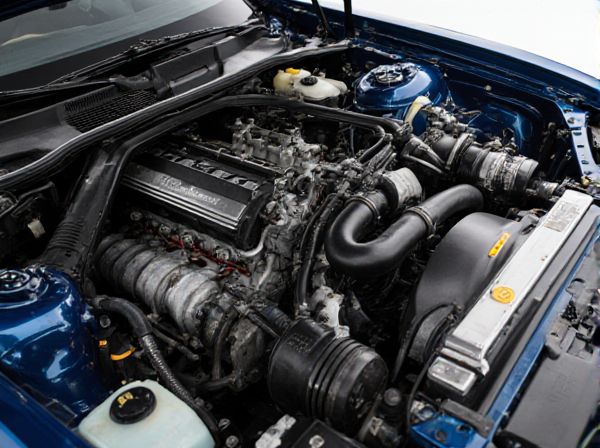
Photo illustration: Naturally Aspirated vs Forced Induction
Naturally aspirated engines rely on atmospheric pressure to draw air into the combustion chamber, offering a simpler design and more linear power delivery. Forced induction systems, such as turbochargers or superchargers, compress air to increase engine power output and efficiency by allowing more fuel to be burned. Choosing between these depends on your preference for engine responsiveness, complexity, and power requirements.
Table of Comparison
| Feature | Naturally Aspirated Engine | Forced Induction Engine |
|---|---|---|
| Air Intake | Air drawn naturally by engine vacuum | Air compressed by turbocharger or supercharger |
| Power Output | Lower peak power, relies on displacement | Higher power from increased air and fuel mixture |
| Complexity | Simple design, fewer components | More complex, includes turbo/supercharger, intercooler |
| Fuel Efficiency | Generally less efficient at higher power levels | Improved efficiency due to better air-fuel mixture |
| Maintenance | Lower maintenance, fewer failure points | Higher maintenance, potential turbo lag and wear |
| Throttle Response | Immediate and linear response | May experience turbo lag or delayed response |
| Cost | Lower initial cost | Higher cost due to additional components |
Introduction to Engine Induction Types
Engine induction types significantly impact performance characteristics, with naturally aspirated engines relying solely on atmospheric pressure to fill cylinders, resulting in linear power delivery and simpler design. Forced induction engines use turbochargers or superchargers to compress intake air, increasing oxygen availability for combustion and enhancing power output. Understanding these fundamental differences is crucial for optimizing engine efficiency and performance in automotive applications.
What is Naturally Aspirated?
Naturally aspirated engines rely exclusively on atmospheric pressure to draw air into the combustion chamber, without the aid of turbochargers or superchargers. This design results in a more linear throttle response and often simpler maintenance compared to forced induction systems. Despite producing less peak power, naturally aspirated engines are favored for their predictable performance and durability in various driving conditions.
What is Forced Induction?
Forced induction is a method used in internal combustion engines to increase air intake pressure, enhancing engine power and efficiency by compressing the air before it enters the combustion chamber. Common types of forced induction include turbocharging and supercharging, which utilize exhaust gases or engine-driven compressors to boost airflow. This process allows more fuel to be burned, resulting in higher performance compared to naturally aspirated engines that rely solely on atmospheric pressure.
Key Differences: NA vs Forced Induction
Naturally aspirated engines rely on atmospheric pressure to draw air into the combustion chamber, resulting in linear throttle response and simpler mechanical design. Forced induction systems, such as turbochargers and superchargers, compress incoming air to increase oxygen density, significantly boosting power output and torque. Key differences include the complexity of the intake system, power delivery characteristics, and potential for increased thermal stress in forced induction engines.
Performance Comparison: Power and Torque
Naturally aspirated engines generate power and torque through atmospheric pressure, resulting in linear throttle response but typically lower peak output compared to forced induction systems. Forced induction engines, utilizing turbochargers or superchargers, compress incoming air to significantly increase power and torque, especially at lower RPMs, delivering stronger acceleration and improved overall performance. The choice between naturally aspirated and forced induction impacts engine efficiency, with forced induction often providing better power density and torque-to-displacement ratio.
Fuel Efficiency and Economy
Naturally aspirated engines typically offer better fuel efficiency at low to moderate loads due to their simpler design and lack of additional components like turbochargers or superchargers. Forced induction engines, such as turbocharged or supercharged models, enhance power output by increasing air intake, which can improve fuel economy when downsizing engine displacement without sacrificing performance. However, forced induction systems may consume more fuel under high boost conditions or aggressive driving, balancing power gains with variable fuel economy outcomes.
Reliability and Maintenance Considerations
Naturally aspirated engines offer greater reliability due to simpler design and fewer components prone to failure, requiring less frequent maintenance than forced induction systems. Forced induction engines, such as turbocharged or supercharged variants, demand rigorous upkeep of additional parts like intercoolers, turbos, or superchargers, increasing the risk of overheating and wear. Regular oil changes and monitoring boost pressure are critical for maintaining performance and longevity in forced induction setups.
Cost Analysis: Initial and Long-term Expenses
Naturally aspirated engines generally have lower initial costs due to simpler design and fewer components compared to forced induction systems like turbochargers or superchargers, which require specialized parts and installation. Long-term expenses for forced induction vehicles often rise because of increased maintenance, potential for higher repair costs, and more frequent replacement of components subject to greater thermal and mechanical stress. Conversely, naturally aspirated engines tend to offer more predictable maintenance costs and better reliability, reducing overall expenditure over the vehicle's lifespan.
Application Suitability: Street, Track, and Off-road
Naturally aspirated engines excel in street applications due to their linear power delivery and simpler maintenance, providing reliable performance for daily driving. Forced induction engines, such as turbocharged or supercharged units, deliver higher power and torque, making them ideal for track use where rapid acceleration and peak output are critical. Off-road vehicles benefit from forced induction's enhanced low-end torque and altitude compensation, improving performance in challenging terrains and varied elevations.
Which is Better for You?
Choosing between naturally aspirated and forced induction engines depends on your driving preferences and needs. Naturally aspirated engines offer linear power delivery and reliability, ideal for daily driving and long-term maintenance ease. Forced induction engines, such as turbocharged or supercharged variants, provide higher power output and improved efficiency, making them better suited for performance enthusiasts and those requiring extra acceleration.
 caratoz.com
caratoz.com